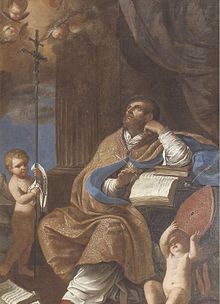Saint Peter Chrysologous (+450) was, as the traditional account has it, chosen bishop of Ravenna in 433 after the then-reigning pontiff, Pope, Sixtus III, had a vision of Saint Peter the Apostle and Saint Apollinaris (the latter a former bishop of Ravenna) who pointed out a young man as the next episcopus. Soon afterwards, a group arrived in Rome from Ravenna, and amongst them was the very man – our saint – whom the Pope recognized from the vision, and so consecrated him bishop.
That’s one dramatic way to discover one’s vocation, and, I must confess, this might seem a more felicitous way of choosing good and worthy shepherds than whatever goes on behind the scenes today.
Peter was known as ‘doctor of homilies’, presenting short sermons expounding Scripture, explaining the Creed, advocating devotion to the Eucharist and the Blessed Virgin, exhorting his flock to receive daily Communion, condemning the heresies of the day – Arianism, Monophysitism being the two then predominant – and explaining all of this in clear and precise terms. We could use far more of such from our modern pulpits, in the midst of what I’m sure many readers will agree is a veritable sea of emotive, homiletic pablum, with everyone and their granny floating up to heaven at the end of their lives regardless of how they’ve lived them (see Anthony Esolen on that theme today over in Crisis). Our diocesan priests could do far worse with their study-time (and, yes, all priests should have study time!) than peruse Chrysologous’ sermons. Now that I think of it, should the canonical requirement that priests maintain a competent level of Latin ever be enforced, translating them as an exercise from their original, sonorous and flowing Roman prose. Galla Placida, regent and mother of the Emperor Valentinian III, loved to hear him, and it was she who gave him the sobriquet chrysologous, or ‘the man with the golden word’, like his earlier Greek near-contemporary, John Chrysostom (+407), the ‘golden mouthed’.
As a sample, here he is from today’s Office:
The earth was adorned with flowers, groves and fruit; and the constant marvellous variety of lovely living things was created in the air, the fields, and the seas for you, lest sad solitude destroy the joy of God’s new creation. And the Creator still works to devise things that can add to your glory. He has made you in his image that you might in your person make the invisible Creator present on earth; he has made you his legate, so that the vast empire of the world might have the Lord’s representative. Then in his mercy God assumed what he made in you; he wanted now to be truly manifest in man, just as he had wished to be revealed in man as in an image. Now he would be in reality what he had submitted to be in symbol.
Peter died after a fruitful seventeen-year reign as bishop of Ravenna, on July 31st, 450, with his feast placed on this day in 1969, before Saint Ignatius tomorrow. He was declared a Doctor of the Church in 1729 by Pope Benedict XIII.
Saint Peter Chrysologous – ora pro nobis!


